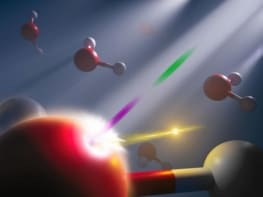
A single molecule has been created by combining individual atoms of sodium and caesium, using optical tweezers to guide them into place. The technique, devised by Lee Liu and colleagues at Harvard University and Harvard-MIT Health Sciences and Technology, could help chemists to study chemical reactions far more precisely by giving them control over the individual atomic and molecular collisions. The team hopes that their method will be used in a variety of fields to create diverse, complex molecules, allowing for discoveries of previously unforeseen molecular properties.
Conventional studies of chemical reactions involve observing the macroscopic results of large numbers of collisions of atoms and molecules – rather than studying individual collisions. Currently, chemists need to compare experimental reaction rates with theoretical models to calculate the probabilities of individual collisions taking place – a process that is fundamental to the understanding of chemistry. An alternative, and more precise, technique is to study interactions between individual atoms and molecules – something that requires great experimental dexterity.
To begin their interaction process, Liu and colleagues use magneto-optical traps to prepare reservoirs of stationary atoms of sodium and caesium at just a few hundred microkelvin. “Cooling and controlling atoms and molecules to temperatures where they are standing still allows for easier manipulations of their properties, interactions and reactions,” explains team leader Kang-Kuen Ni.
Polarizing forces
The chilly temperature means that individual atoms can be easily loaded onto optical tweezers – specialized, highly-focused laser beams that can trap dielectric particles including atoms. To confirm that the tweezers had been loaded successfully, the researchers use spectroscopic techniques to check for the presence of each atom.
One optical tweezer – based on 700 nm-wavelength light – holds the sodium atom, while another tweezer at 976 nm holds the caesium atom. To bring the atoms close together, the team move the tweezer containing the sodium atom so that it overlaps with the tweezer containing the caesium atom. Then, the 700 nm light is switched off. The 976 nm laser is capable of holding both atoms, so the sodium and caesium are trapped together.
The team found that simply bringing the atoms together is not enough to form a molecule – a pulse of light is required. “The atoms couldn’t turn into a molecule just through an isolated collision, as they had to simultaneously conserve energy and momentum – something very difficult to achieve in experimental conditions,” Ni explains. “To solve this, we shone another laser tuned to the resonance wavelength of the molecule, driving them to form the molecule.” The excited molecule which formed quickly decayed into a stable ground state, allowing for observations of its properties. “This was the first time that a molecule has been assembled starting from exactly two atoms, and establishing individual control over each of them,” said Ni.
New and unexpected
Even for such a simple molecule, the team observed new and unexpected properties in their creation. “We saw new molecular spectroscopic lines, and that contributed to a deeper understanding of the overall picture,” explains Ni. The researchers believe their technique could soon be expanded to study complex chemical processes.

Applying physics to biology: optical tweezers and single-molecule biophysics
“We are now thinking of working with many optical tweezers and many molecules simultaneously, allowing for studies of their interactions or reactions,” Ni says. With this technology available, it could soon be possible for chemists to synthesize their own designer molecules, with applications ranging from new medicines to qubits in quantum computers.
The research is described in Science.



